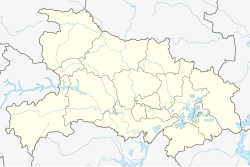Hanyang
汉阳区 | ||||||||||||||||||||||||||||||||||||
|---|---|---|---|---|---|---|---|---|---|---|---|---|---|---|---|---|---|---|---|---|---|---|---|---|---|---|---|---|---|---|---|---|---|---|---|---|
 View of Hanyang District | ||||||||||||||||||||||||||||||||||||
 | ||||||||||||||||||||||||||||||||||||
| Coordinates: 30°32′23″N 114°12′43″E / 30.5397°N 114.2119°E[1] | ||||||||||||||||||||||||||||||||||||
| Country | People's Republic of China | |||||||||||||||||||||||||||||||||||
| Province | Hubei | |||||||||||||||||||||||||||||||||||
| Sub-provincial city | Wuhan | |||||||||||||||||||||||||||||||||||
| Township-level (4th) subdivisions | 13 | |||||||||||||||||||||||||||||||||||
| Area | ||||||||||||||||||||||||||||||||||||
• Total | 108.34 km2 (41.83 sq mi) | |||||||||||||||||||||||||||||||||||
| Population (2020)[3] | ||||||||||||||||||||||||||||||||||||
• Total | 837,263 | |||||||||||||||||||||||||||||||||||
| • Density | 7,700/km2 (20,000/sq mi) | |||||||||||||||||||||||||||||||||||
| Time zone | UTC+8 (China Standard) | |||||||||||||||||||||||||||||||||||
| Wuhan district map |
| |||||||||||||||||||||||||||||||||||
| Website | www | |||||||||||||||||||||||||||||||||||
| Hanyang, Wuhan | |||||||||
|---|---|---|---|---|---|---|---|---|---|
| Traditional Chinese | 漢陽區 | ||||||||
| Simplified Chinese | 汉阳区 | ||||||||
| |||||||||
Hanyang District (simplified Chinese: 汉阳区; traditional Chinese: 漢陽區; pinyin: Hànyáng Qū) forms part of the urban core of and is one of 13 urban districts of the prefecture-level city of Wuhan, the capital of Hubei Province, China. Currently, it is a district and stands between the Han River (right/southern bank) and the Yangtze River (left/northwestern bank), where the former drains into the latter. It is connected by bridges with its former sister cities, Hankou and Wuchang. Presently, on the left bank of the Yangtze, it borders the districts of Qiaokou to the north across the Han River, Jianghan to the northeast, Caidian to the southwest, and Dongxihu to the northwest; on the opposite bank it borders Wuchang and Hongshan. Guiyuan Temple is located in Hanyang.
The name "Hanyang" means "the Yang side of Han River", referring to the town's historic location on the north ("yang") bank of the Han River mouth. However, the lower Han River changed course to the north side of the town during Ming dynasty's Chenghua-era. The town, now on the south ("yin") side of the river, should have been renamed to "Hanyin" by naming convention, but the name "Hanyang" remained as it was well-established since the Sui dynasty. Administratively, the area forms Hanyang District of the modern Wuhan city, with an area of 108 square kilometers (42 sq mi) and a population of 510,000.[4]
The Hanyang Arsenal is known for its production of the so-called "Hanyang rifle" - an indigenous Asian copy of the German Model 1888 Commission Rifle, which was heavily used in World War II, as well as in the Korean War and Vietnam War.
- ^ "Hanyang" (Map). Google Maps. Retrieved 2014-07-02.
- ^ "Wuhan Statistical Yearbook 2010" (PDF). Wuhan Statistics Bureau. Archived from the original (PDF) on 5 November 2011. Retrieved 31 July 2011.p. 15
- ^ "China: Húbĕi (Prefectures, Cities, Districts and Counties) - Population Statistics, Charts and Map". www.citypopulation.de. Retrieved 2024-11-22.
- ^ (in Chinese) Profile of Hanyang Archived 2008-03-28 at the Wayback Machine, Official website of Hanyang District Government, visited on April 19, 2008.

